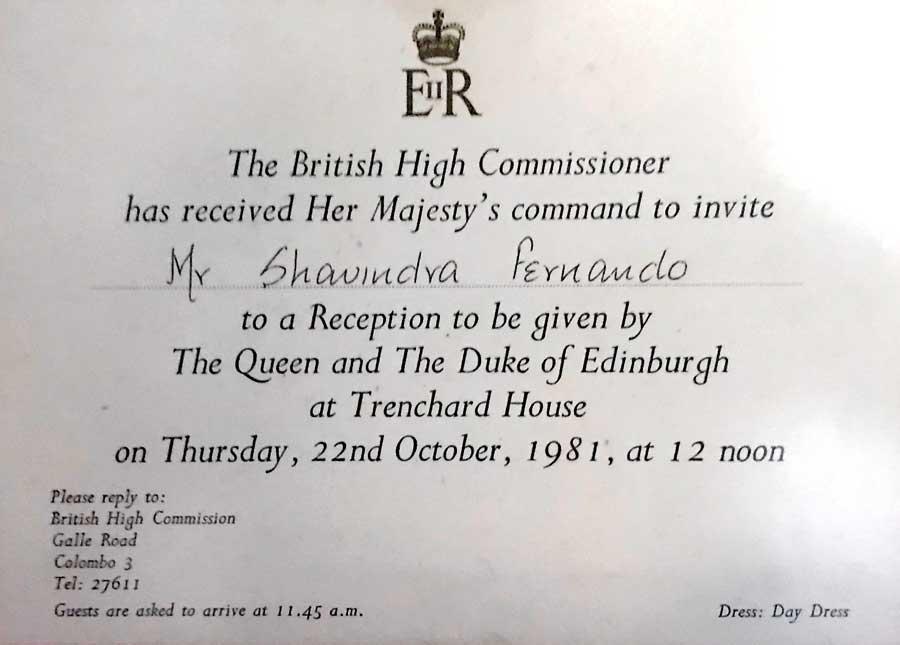Reply To:
Name - Reply Comment

It was on October 22 in 1981 in Colombo.
I was 22, the youngest of the Sri Lanka Press Corps of around a dozen reporters, who were afforded an audience with the Queen of England and the Duke of Edinburgh in Colombo. I was a reporter for the Ceylon Daily Mirror of the Times of Ceyon.
The Duke of Edinburgh’s tie pin at the Trenchard House reception was a green elephant. Much to the horror of the few British diplomats present, one of our reporters (from the UNP party journal, Siyarata) touched Prince Philip’s tie and said “Sir you are wearing our party colours and our green elephant”.
The Prince and the Queen were amused, laughed, and the Prince explained that it was a symbol of elephant conservation, a global organization which he headed. We had about an hour with the Royals, drinks flowed freely, we reporters were all high and spoke freely, and the accompanying British press and regular Royal staff entourage who were not a part of this tiny gathering said later, that they were taken aback, as to how freely the Royals had entertained us. Some of the British reporters had never had such a reception.
In retrospect, I believe the Royals felt that despite our relative Sri Lankan “press” disregard for propriety and decorum, we reporters warmly and genuinely reflected the public feeling of goodwill that still existed towards the British Royals in Sri Lanka. But none of us were as forward as the UNP Siyarata reporter, and we knew he was a political intruder who had been included by our government, when he had no business to be there as a reporter of a party newspaper.
It was the second Royal visit to the island (since 1954) after 27 years. “We Sri Lankans” who gained our independence (in 1948) without a single shot being fired, when our first Prime-Minister clad in a three piece suit and tails, bowed gracefully before the Duke and Duchess of Gloucester and accepted independence, were still determined to put on a grand show, for the British Royals.
Despite Her Majesty being no longer our Head of State (after the Republican Constitution of 1972), we were going to name the countries US$ 700 million largest dam, after her grandmother as the “Victoria Dam”.
As a reporter of the crumbling “Times of Ceylon” (1846 to 1985) in Fort, I was assigned “The Royal Visit”. It had its dramatic moments, which I cherish to date.
"At Polonnaruwa, the Royals stayed at the Polonnaruwa Rest House, in the same room they had stayed in 1954, and none of us believed the story of the Rest House security guard who said that he was around even in 1954, and none of us reporters were willing to write his claim to fame"
About two weeks before the Royal visit, a man turned up at the Daily Mirror editorial office with two large carved wooden Storks (about four feet in height). He wanted to present it to the Royals, and he wanted me to write about it. He was a poor villager. I had the two birds photographed and got his story, which was not much of a story, other than a simple village man wanting to give a gift to the Royals. I was frank with him and told him that it was very unlikely, and it was the British High Commission that decides on such business, and told him how to set about it.
On the first day of the Royal visit, when the Queen addressed the nation at the Galle Face Green to mark 50 years of adult universal suffrage in the island, it was packed with large crowds. From our press box (to my horror) I saw the two storks advancing quietly through the heads of the masses. They got right up to the barricade, their keeper determined to make a rush across the road to the Royal podium, and I was about to take “the picture”, when state security intervened and I saw a scuffle, and the two storks disappearing into the crowds, and that story of simple unsophisticated goodwill remained untold.
But there were also real security concerns.
“After the Queen had completed a 140-mile overnight train trip from Colombo to central Sri Lanka, a British official acknowledged that she ‘’probably didn’t spend a too restful night.’’ Albin Krebs Robert McG. Thomas Jr.”
There were many security issues which the local press corps did not want to report. The goodwill and success of this visit was of national importance to the J.R. Jayewardena’s UNP government, emerging out of socialism into neo-liberalism with British Thatcherism, and being challenged by LTTE separatist terrorism.
Then the nightmare began. The train carrying the Queen and the Prince got its brakes locked in the middle of a jungle track near Sigiriya and the Royals had to spend the night in the train, in the middle of the jungle. By then, the British press corps had abandoned the Royals and gone north to get LTTE stories, much to the relief of Sri Lankan officials. We decided that we were going along with our government officials and will not write this story. There was very real concern or fear of the remote possibility of a sensational LTTE attack, even though by 1981 the LTTE was not yet known for high profile attacks.
Despite the goodwill visit was to generate only soft stories, and none of us were going to write the embarrassing tale of the train breakdown, we were still in competition among each other to get that Royal scoop, with even a slight element of sensationalism. At the Victoria Reservoir construction site I managed to “talk” to a high ranking military official in attendance to the Minister in Attendance, in an unguarded moment. He was privy to the minister’s conversation with the Royals.
So the Sunday Times headlined my “exclusive” story: “QUEEN WANT’S PROGRESS REPORT”.
At Polonnaruwa, the Royals stayed at the Polonnaruwa Rest House, in the same room they had stayed in 1954, and none of us believed the story of the Rest House security guard who said that he was around even in 1954, and none of us reporters were willing to write his claim to fame.
Walking among the tenth century Royal ruins of the Sinhalese kings, what amused the Prince most was the Royal urinals hewn of rock with quite an elaborate flush system. Were they amused that we were a people who had done it with some style, even ten centuries ago. After some time the queen herself did not seem too keen to proceed with the conversation on those lines, but the Duke visibly continued to be amused by the whole business, and gestured to us reporters, who incidentally were an all-male press corps, and with the prince we all enjoyed the subject in focus, of which nothing was said, and nothing was reported.
“My” most amusing memory of the British Royal Visit of 1981 however, came from someone else. The legendry Daily Mirror editor Reggie Michael ghost wrote my masterpiece, the story of the “boy” who covered the Royal visit, for the rival “Sunday Observer”.
“After I had filed my copy after the Trenchard House reception and walked out of the editorial office, I was surprised to see my parents waiting for me. “Did you wash your hands”, my mother asked me. When I said “no”, she heaved a sigh of relief and the next thing I knew was that my mother and father bundling me into the backseat of a yellow topped black Morris Minor taxi. It sped through the streets of Colombo with my parents sitting beside me not uttering a word, but looking at me with some kind of admiration, I had never witnessed before.
Outside our house, almost all my known relations, including third cousin girls who never looked at me were gathered. As I was ushered out of the car, I was mobbed by my relatives, and my aunts wept as they touched and kissed my hand, and my mother proclaimed that it was the hand of her son who shook hands with British Royalty. That was to become my claim to fame in my family circle, as the first among us, as “The boy who shook hands with the Queen of England, and the Duke of Edinburgh”.